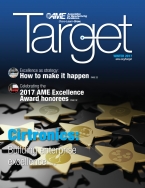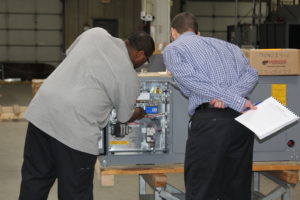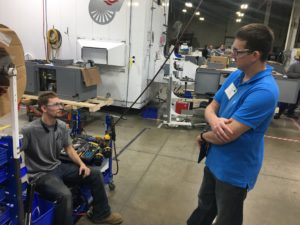Reprinted with permission from the Winter 2017 issue of Target, an AME Publication. Authored by Lea Tonkin
Cambridge Engineering employees are growing even faster than the company
 Inspiring stories about lean and enterprise-wide transformation can sometimes seem too good to be true. This is the feeling Marc Braun, president of Cambridge Engineering, Inc. in Chesterfield, Missouri has about the company’s cultural transformation during the past several years. “It is incredibly humbling to walk into the plant and see how our people are growing and how much joy lean has brought into their lives,” Braun said. “You wouldn’t believe it unless you experienced it for yourself.” The family-owned heating and ventilation system manufacturing company is known for high-quality products and a strong family culture. What’s happening now, through lean, is different. John Kramer, Jr., chairman and CEO, shared, “People know me as a being a big dreamer, but the impact our people at Cambridge are making in others’ lives exceeds my wildest dreams. I believe the journey we are on is one that will ultimately restore glory and dignity to manufacturing in America.”
Inspiring stories about lean and enterprise-wide transformation can sometimes seem too good to be true. This is the feeling Marc Braun, president of Cambridge Engineering, Inc. in Chesterfield, Missouri has about the company’s cultural transformation during the past several years. “It is incredibly humbling to walk into the plant and see how our people are growing and how much joy lean has brought into their lives,” Braun said. “You wouldn’t believe it unless you experienced it for yourself.” The family-owned heating and ventilation system manufacturing company is known for high-quality products and a strong family culture. What’s happening now, through lean, is different. John Kramer, Jr., chairman and CEO, shared, “People know me as a being a big dreamer, but the impact our people at Cambridge are making in others’ lives exceeds my wildest dreams. I believe the journey we are on is one that will ultimately restore glory and dignity to manufacturing in America.”  Introducing lean concepts in the plant more than ten years ago seemed a logical step to Kramer. Many experts said to start with 5S improvement projects, train the workforce on Japanese terms, and then add a host of metrics and plan white boards – adding to the mix of daily priorities. Although some progress was made during this time, it was top-down driven and merely tolerated rather than embraced by employees. “There were too many metrics, and there was too much focus on cost rather than on people,” Kramer noted. “Our busy season (fall through January) would hit, and I would tell my people to stop improvements and ship products. All of our lean principles would go out the window, as people didn’t have time to make improvements. Although I had a glimpse of the vision of a lean culture, many times it felt like we were going backward rather than forward.”
Introducing lean concepts in the plant more than ten years ago seemed a logical step to Kramer. Many experts said to start with 5S improvement projects, train the workforce on Japanese terms, and then add a host of metrics and plan white boards – adding to the mix of daily priorities. Although some progress was made during this time, it was top-down driven and merely tolerated rather than embraced by employees. “There were too many metrics, and there was too much focus on cost rather than on people,” Kramer noted. “Our busy season (fall through January) would hit, and I would tell my people to stop improvements and ship products. All of our lean principles would go out the window, as people didn’t have time to make improvements. Although I had a glimpse of the vision of a lean culture, many times it felt like we were going backward rather than forward.”
Staying focused: A Turning Point
After working with an executive coach and following the plan for organizational health described in Patrick Lencioni’s book, “The Advantage,” Kramer determined that his leadership was the biggest challenge and barrier to making the cultural changes he envisioned in the company. “I would whipsaw the organization in a million directions without giving them the chance to make progress,” he said. “Once I stopped and allowed the team to focus on the key areas for success, and develop a rhythm and pace, the cultural progress started to come alive.” During this period of growth, operational team members came back after a lean benchmarking trip to FastCap Paul Akers’ facility in Washington state. “They were excited about his book, ‘2 Second Lean,” Kramer said. “They had met with Paul and learned that you can take something complex and make it simple- a way for people to make improvements and prosper. We starting making simple improvements, opening up more dialog with our employees. The concept was embraced by our organizational leadership and also resonated with me and our executive team members, because it focused on people growth and engagement. Because it was so simple to understand and was people-focused, the team was able to quickly share with others inside the company, and we haven’t looked back since.” Akers strongly encourages readers to start their lean journey by learning to see waste, allowing people to “fix what bugs them,” and then to make short videos for sharing improvements with others. “I remember how excited our leaders became about the concepts taught in “2 Second Lean.” Their courage to try something new and experiment with videos was amazing,” said Braun, who was the executive vice president of sales and marketing at the time. “Our marketing department had utilized video sparingly. We had a collection of several videos reflecting the “Cambridge Story,” and little presence on YouTube. The company now has more than 4,300 videos created by employees, demonstrating their genius. It has been like pouring gasoline on a fire.” Here’s where employees shine, as they share one-minute videos they’ve made about recent improvements. Sometimes there are accounts of rapid changes to eliminate wasted steps or prevent over-reaching at a work station, for example; or there may be videos reflecting several improvements over an extended period of time. “Making videos of your improvements helps to reinforce that you are making a contribution, “ said Greg Sitton, plant manager. Every employee is encouraged to make one-minute videos. Although some associates readily take to the camera, others need help and teammates step in to capture the improvements. To see an associate video, click here. Stay tuned for the next installment to be published January 16th!
During this period of growth, operational team members came back after a lean benchmarking trip to FastCap Paul Akers’ facility in Washington state. “They were excited about his book, ‘2 Second Lean,” Kramer said. “They had met with Paul and learned that you can take something complex and make it simple- a way for people to make improvements and prosper. We starting making simple improvements, opening up more dialog with our employees. The concept was embraced by our organizational leadership and also resonated with me and our executive team members, because it focused on people growth and engagement. Because it was so simple to understand and was people-focused, the team was able to quickly share with others inside the company, and we haven’t looked back since.” Akers strongly encourages readers to start their lean journey by learning to see waste, allowing people to “fix what bugs them,” and then to make short videos for sharing improvements with others. “I remember how excited our leaders became about the concepts taught in “2 Second Lean.” Their courage to try something new and experiment with videos was amazing,” said Braun, who was the executive vice president of sales and marketing at the time. “Our marketing department had utilized video sparingly. We had a collection of several videos reflecting the “Cambridge Story,” and little presence on YouTube. The company now has more than 4,300 videos created by employees, demonstrating their genius. It has been like pouring gasoline on a fire.” Here’s where employees shine, as they share one-minute videos they’ve made about recent improvements. Sometimes there are accounts of rapid changes to eliminate wasted steps or prevent over-reaching at a work station, for example; or there may be videos reflecting several improvements over an extended period of time. “Making videos of your improvements helps to reinforce that you are making a contribution, “ said Greg Sitton, plant manager. Every employee is encouraged to make one-minute videos. Although some associates readily take to the camera, others need help and teammates step in to capture the improvements. To see an associate video, click here. Stay tuned for the next installment to be published January 16th!